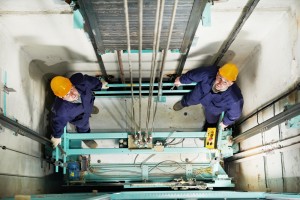 It’s a horror movie staple: people are trapped in an elevator when the steel cable snaps, plunging the hapless occupants to their deaths. In reality, that’s only sort of happened once in the history of elevators, and it was totally not the elevator’s fault.
It’s a horror movie staple: people are trapped in an elevator when the steel cable snaps, plunging the hapless occupants to their deaths. In reality, that’s only sort of happened once in the history of elevators, and it was totally not the elevator’s fault.
In 1945, a B-25 bomber pilot got lost over Manhattan and made a wrong turn into the 79th floor of the Empire State Building. The crash sliced the steel cables supporting two elevators, which both fell to the bottom of the shaft. One was occupied, but the woman survived her 75-story fall thanks to the elevator’s safety features and the 1,000 feet of snapped steel cable piled up at the bottom of the shaft, which cushioned the fall.
However, for all its durability and safety as the material of choice for elevator cables, steel has also held us back. Its sheer weight has meant limitations on how high we can build skyscrapers. The longer the cable, the heavier it is, so once you get past about 1,640 feet (500 meters), the cable becomes too heavy to efficiently move the elevator car up and down the shaft. The weight of the cable would cause it to snap at around 3,200 feet.
Designers have bypassed this limitation with “sky lobbies.” One elevator carries passengers as high as possible, then occupants exit that elevator and get on another (supported by a different cable) to continue their upward journey. That’s not a perfect solution either, however, especially if you want to construct a mile-high skyscraper of the kind Frank Lloyd Wright dreamed of one day building in Chicago. You’d have to create multiple sky lobbies and elevators, consuming valuable space and time.
Now, thanks to polymer science and its deft application by one Finnish elevator company, the sky really may become the limit for building heights. Elevator manufacturer KONE has created UltraRope, a cable made with carbon fiber and a polyurethane coating to solve the height and weight problems. The company patented the belt-like rope in 2008 and spent seven years testing and perfecting it. In 2014, the builders of Kingdom Tower in Saudi Arabia tapped KONE to build the elevators in what will become the world’s tallest building; the Kingdom Tower will rise 1 kilometer above the Red Sea when it’s completed in 2018.
UltraRope delivers lightweight strength through its physical shape (it’s wider than it is thick and sports V-shaped longitudinal grooves) and its creation with epoxy, polyester, phenoic and vinyl ester resins. The polymer composites impart strength with a fraction of the weight of steel cables. In fact, KONE says UltraRope is about 90 percent lighter than traditional steel cables. The weight savings mean elevators can be more energy efficient and building designers can create higher buildings without having to worry about cost, safety and physical limitations associated with very long steel elevator cables.
Imagine that — Lloyd-Wright’s dream of a mile-high building may one day become a reality. And the fear of snapping steel elevator cables can stay forever in the realm of bad fiction!
